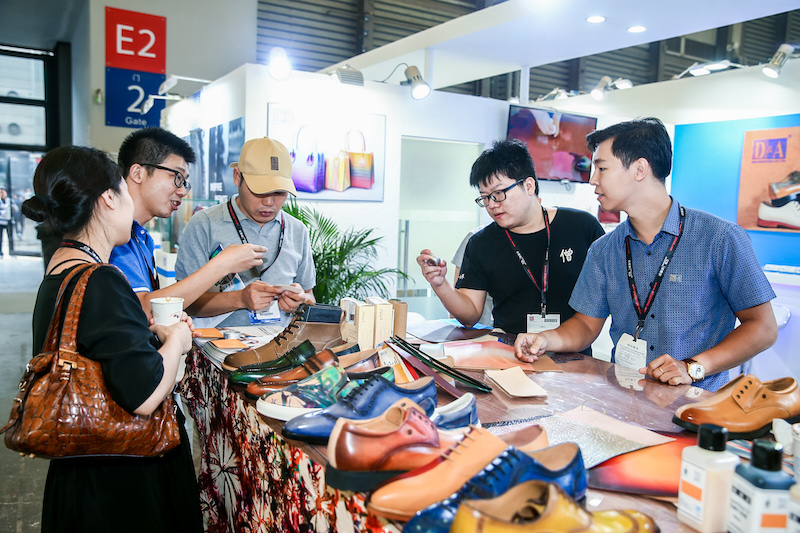14 March 2023

After a hiatus of four years since the last edition was held in 2019, the All China Leather Exhibition (ACLE) will return to Shanghai to hold its 23rd edition from 29 – 31 August, at the Shanghai New International Exhibition Centre (SNIEC), in the financial district of Pudong.
Background
Organised by APLF Ltd and the China Leather industry Association (CLIA), ACLE was launched in 1998 and is a business platform for international suppliers to have direct access to China’s leather and manufacturing industries while being the main national fair for domestic companies from the sector.
Over two decades, the fair expanded steadily reflecting the growth of China’s tanning and leather manufacturing industries. The complete supply chain of the leather manufacturing process is represented at the fair from raw materials and chemical suppliers for the tannery, finishing machinery and a whole host of semifinished and finished leathers for multiple applications, such as footwear, leathergoods, automotive, upholstery and garments.
Buyers
In recent editions, ACLE has attracted around 23,000 buyers, the vast majority of whom (around 19,000) come from the main manufacturing provinces of China. Due to its combination of domestic and international exhibitors, ACLE has become the definitive sourcing fair in China and beyond for the China and ASEAN leather-making and manufacturing sectors.
Now that China has reopened for business after the easing of strict travel restrictions imposed by the authorities during the pandemic, China’s leather sector is in need of a professional business platform to reinvigorate its industry and reunite the sector under one roof. ACLE will serve to bring business activity and supplier-customer relations back on track after a gap of four years.
Economic outlook
Shortly after the lifting of Covid restrictions in late December, the IMF revised the outlook for China’s GDP growth for 2023 sharply up from the October forecast of 4.4%, to 5.2% for 2023. Since both economic growth and the recovery in the leather industry depend on consumer demand, this revised GDP forecast should filter through into the leather sector.
Taking into account that the IMF is projecting global economic growth at 2.9% in its January forecast, the US economy to grow at 1.4% with Europe essentially flat with the possibility of tipping into a recession, China’s leather sales may be more reliant on domestic demand to compensate for weaker exports to developed economies.
An important sector for leather demand is the automotive industry that grew by 2.1% to 26.9 million units registered in 2022 (including trucks and buses). According to the China Association of Automobile Manufacturers (CAAM) it is expected to grow by a further 3% in 2023.
Sales increases in big-ticket items such as automobiles reflected the underlying buoyancy of the economy and should help demand in the leather sector.
Opportunities in the leather sector
According to the latest report issued by the CLIA, key companies in China’s leather industry generated the sales revenue of 1.16 trillion yuan in 2022, decreasing slightly by 0.1% from the previous year.
Exported leather, leather products and footwear (including raw hide) products were US$107.55 billion, increasing by 19.3% from the previous year. The performance remained stable with constant double-digit growth.
Imported leather, leather products and footwear (including raw hide) products were US$17.27 billion of which US$3.27 billion was accounted for by all types of leather. This amounted to a decreasing of 11.9% from the previous year. Due to the pandemic, the imported raw materials for finished products declined but with large volumes required to feed the production lines, there are still ample opportunities of doing business with Chinese importers and manufacturers.
Macroeconomic pointers
Add to this that according to Ipsos Consolidated Economic Indicators based on monthly surveys the Consumer Confidence Index for China ranged at 73.6 points in January 2023, up from 72.2 the previous month. In comparison, the Consumer Confidence Index for the US stood at 50.2 points in January 2023.
Another key economic indicator in January 2023 is the Purchasing Managers’ Index (PMI) which in China, resided at about 50.1 percent. There was a sharp increase in industrial activity in February, the fastest in a decade according to the BBC, and this resulted in China’s PMI jumping to 52.6 in just one month. An indicator of the economic health of the manufacturing sector, the PMI is based on five major indicators: new orders, inventory levels, production, supplier deliveries, and the employment environment.
Conclusion
After the ups and downs experienced by the Chinese economy in 2022 due to lockdowns and Covid restrictions, the path is now clear to reflate the economy and drive forward manufacturing activity and consumer demand.
This will filter through to all industry sectors and even if adjustments are made in the first quarter of the year, Chinese companies are now exhibiting abroad, and a solid economic recovery should be underway by the second half of 2023.
This will benefit the leather industry, stimulate demand, offer export opportunities to western companies seeking to reestablish business with Chinese customers.
ACLE is the ideal platform from where to undertake this activity.
To reserve your stand and participate in China’s leading event for the leather industry, contact us by email at [email protected]
We bring leather, material and fashion businesses together: an opportunity to meet and greet face to face. We bring them from all parts of the world so that they can find fresh partners, discover new customers or suppliers and keep ahead of industry developments.
We organise a number of trade exhibitions which focus on fashion and lifestyle: sectors that are constantly in flux, so visitors and exhibitors alike need to be constantly aware both of the changes around them and those forecast for coming seasons.